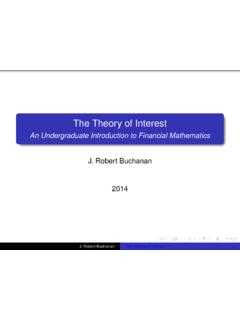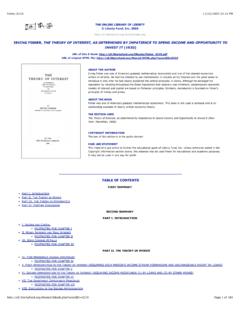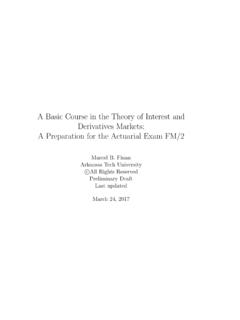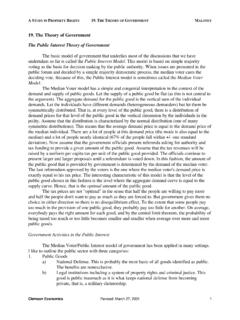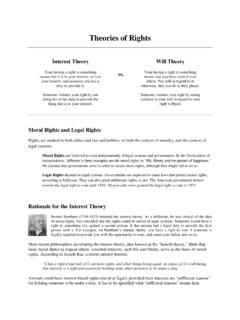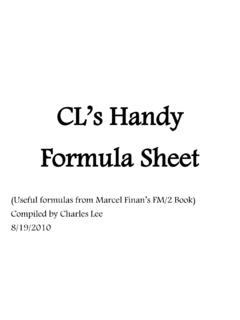Transcription of The Theory of Interest - Millersville University of ...
1 The Theory of InterestAn Undergraduate Introduction to Financial MathematicsJ. Robert Buchanan2010J. Robert BuchananThe Theory of InterestSimple Interest (1 of 2)DefinitionInterestis money paid by a bank or other financial institution toan investor or depositor in exchange for the use of thedepositor s of Interest is (usually) a fraction (called theinterestrate) of the initial amount deposited called Robert BuchananThe Theory of InterestSimple Interest (2 of 2)Notation:r: Interest rate per unit timeP:principal amountA:amount due (account balance)t:timeThese quantities are related through the equation:A=P(1+rt).J.
2 Robert BuchananThe Theory of InterestCompound Interest (1 of 2)Once credited to the investor, the Interest may be kept by theinvestor, and may earn Interest Interest is credited once per year, then aftertyears theamount due isA=P(1+r) Robert BuchananThe Theory of InterestCompound Interest (2 of 2)If a portion of the Interest is credited after a fraction of a year,then the Interest is said to there arencompounding periodsper year, then intyearsthe amount due isA=P(1+rn) Robert BuchananThe Theory of InterestExamples (1 of 2)ExampleSuppose an account earns annually compoundedmonthly. If the principal amount is $3104 what is the amountdue after three and one-half years?
3 J. Robert BuchananThe Theory of InterestExamples (1 of 2)ExampleSuppose an account earns annually compoundedmonthly. If the principal amount is $3104 what is the amountdue after three and one-half years?Solution:A=P(1+rn)tn=3104(1+ )( )(12) Robert BuchananThe Theory of InterestExamples (2 of 2)ExampleSuppose an account earns annual simple Interest . If theprincipal amount is $3104 what is the amount due after threeand one-half years?J. Robert BuchananThe Theory of InterestExamples (2 of 2)ExampleSuppose an account earns annual simple Interest . If theprincipal amount is $3104 what is the amount due after threeand one-half years?
4 Solution:A=P(1+rt)=3104(1+ ( )) Robert BuchananThe Theory of InterestEffective Interest RateDefinitionThe annual Interest rate equivalent to a given compoundinterest rate is called theeffective Interest (1+rn)n 1J. Robert BuchananThe Theory of InterestExampleExampleSuppose an account earns annually compoundedmonthly. What is the effective Interest rate?J. Robert BuchananThe Theory of InterestExampleExampleSuppose an account earns annually compoundedmonthly. What is the effective Interest rate?re=(1+rn)n 1=(1+ )12 1 Robert BuchananThe Theory of InterestContinuous CompoundingWhat happens as we increase the frequency of compounding?
5 A=limn P(1+rn)ntJ. Robert BuchananThe Theory of InterestContinuous CompoundingWhat happens as we increase the frequency of compounding?A=limn P(1+rn)ntDefinitionThe amount due forcontinuously compounded interestisA=PertJ. Robert BuchananThe Theory of InterestExample (1 of 2)ExampleSuppose $3585 is deposited in an account which pays interestat an annual rate of compounded the amount due after two and one half the equivalent annual effective simple Interest Robert BuchananThe Theory of InterestExample (2 of 2)1 Amount due:A=Pert= ( ) rate:re=er 1= 1 Robert BuchananThe Theory of InterestPresent ValueHow do we rationally compare amounts of money paid atdifferent times in an Interest -bearing environment?
6 J. Robert BuchananThe Theory of InterestPresent ValueHow do we rationally compare amounts of money paid atdifferent times in an Interest -bearing environment?DefinitionThepresent valueofA, an amount duetyears from nowsubject to an Interest rateris the principal amountPwhichmust to invested now so thattyears from now the accumulatedprincipal and Interest Robert BuchananThe Theory of InterestPresent ValueHow do we rationally compare amounts of money paid atdifferent times in an Interest -bearing environment?DefinitionThepresent valueofA, an amount duetyears from nowsubject to an Interest rateris the principal amountPwhichmust to invested now so thattyears from now the accumulatedprincipal and Interest (1+rn) nt(discrete compounding)J.
7 Robert BuchananThe Theory of InterestPresent ValueHow do we rationally compare amounts of money paid atdifferent times in an Interest -bearing environment?DefinitionThepresent valueofA, an amount duetyears from nowsubject to an Interest rateris the principal amountPwhichmust to invested now so thattyears from now the accumulatedprincipal and Interest (1+rn) nt(discrete compounding)P=Ae rt(continuous compounding)J. Robert BuchananThe Theory of InterestExample (1 of 2)ExampleSuppose an investor will receive payments at the end of thenext six years in the amounts shown in the the Interest rate is compounded monthly, what is thepresent value of the investments?
8 J. Robert BuchananThe Theory of InterestExample (2 of 2)Solution:P=6 i=1(Ai(1+ ) 12i) Robert BuchananThe Theory of InterestGeometric SeriesTheoremIf a6=1thenS=1+a+a2+ +an=1 an+11 Robert BuchananThe Theory of InterestGeometric SeriesTheoremIf a6=1thenS=1+a+a2+ +an=1 an+11 +a+a2+ +anthenaS=a+a2+ +an+an+1andS aS= (1+a+a2+ +an) (a+a2+ +an+an+1)S(1 a) =1 an+1S=1 an+11 aJ. Robert BuchananThe Theory of InterestLoan Payments (1 of 2)Suppose a loan of amountPwill be paid back discretely (ntimes per year) overtyears. The unpaid portion of the loan ischarged Interest at annual ratercompoundedntimes per is the discrete paymentx?
9 J. Robert BuchananThe Theory of InterestLoan Payments (1 of 2)Suppose a loan of amountPwill be paid back discretely (ntimes per year) overtyears. The unpaid portion of the loan ischarged Interest at annual ratercompoundedntimes per is the discrete paymentx?Hint:the present value of all the payments should equal theamount Robert BuchananThe Theory of InterestLoan Payments (2 of 2)If the first payment must be made at the end of the firstcompounding period, then the present value of all the paymentsisx(1+rn) 1+x(1+rn) 2+ +x(1+rn) nt=x(1+rn) 11 (1+rn) nt1 (1+rn) 1=x1 (1+rn) ntrnThusP=xnr(1 [1+rn] nt)J. Robert BuchananThe Theory of InterestExample (1 of 2)ExampleIf a person borrows $25,000 for five years at an Interest rate compounded monthly and makes equal monthlypayments, what is the monthly payment?
10 J. Robert BuchananThe Theory of InterestExample (2 of 2)Solution:x=Prn(1 [1+rn] nt) 1=25000( )(1 [1+ ] (12)(5)) 1 Robert BuchananThe Theory of InterestRetirement Savings (1 of 2)ExampleSuppose a person is 25 years of age now and plans to retire atage 65. For the next 40 years they plan to invest a portion oftheir monthly income in securities which earn Interest at therate of 10% compounded monthly. After retirement the personplans on receiving a monthly payment (an annuity) in theabsolute amount of $1500 for 30 years. How much should beset aside monthly for retirement?J. Robert BuchananThe Theory of InterestRetirement Savings (2 of 2)Solution:The present value of all funds invested for retirementshould equal the present value of all funds taken out i=1(1+ ) i=1500840 i=481(1+ ) i=1500(1+ ) 480360 i=1(1+ ) ix=1500(1+ ) 480 360i=1(1+ ) i 480i=1(1+ ) i Robert BuchananThe Theory of InterestAdjusting for InflationDefinitionAn increase in the amount of money in circulation without acommensurate increase in the amount of available goods is acondition known asinflation.
